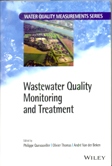
|
WASTEWATER QUALITY MONITORING AND TREATMENT, INDIAN REPRINT - PHILIPPE QUEVAUVILLER (EX) |
Author |
PHILIPPE QUEVAUVILLER
OLIVIER THOMAS
ANDRE VAN DER BEKEN
|
|
Cover Price : Rs 3,995.00
|
Imprint : Wiley India
ISBN : 9788126544318
YOP : 2014
|
Binding : Hardbound
Total Pages : 408
CD : No
|
|
Wastewater monitoring procedures are subject to many drawbacks due to the difficulties in accurately and frequently measuring the necessary variables, which essentially rely on ‘classical’ monitoring approaches involving sampling, storage and laboratory analysis. The only way to make progress in wastewater treatment, and hence to comply with related regulations, is to ensure that the plants are able to work with complete reliability. This implies that reliable monitoring of the wastewater quality and quantity and of the treatment efficiency should be performed for the characterisation of raw and treated wastewaters and for the control of the plant itself.
This book reflects this awareness by summarising different views on wastewater treatment-related monitoring and control. It is composed of six different parts as follows:
• The first part provides an overview of EU and US wastewater policies, standard methodologies, reference materials and discusses sampling assistance, biosensors and alternative methods.
• Sewer quality control is examined in the second part, including considerations on sewage characterisation and evolution, flow measurements and monitoring in rural areas.
• This is followed in the third and fourth parts, by chapters concerning urban wastewater treatment plant control and industrial wastewater treatment plant control.
• Part Five discusses monitoring in the context of discharges and receiving medium, including water quality modelling.
• Finally, socio-economic aspects are considered in the sixth part with a focus on data collection and merging, as well as training.
This book has been written by experts in the field of wastewater treatment policy, control and monitoring. It provides an overview of the existing knowledge in wastewater monitoring and identifies emerging needs, which will be of direct interest to policy makers, water scientist and industry, and analytical control laboratories.
Water Quality Measurement Series
This series provides a comprehensive coverage of the analytical techniques used for the measurement of substances in water, from sampling through to laboratory analysis. The scope of the series encompasses topic issues including quality assurance, standard procedures, and the best practices in measuring water quality, from surface and drinking water to coastal and wastewater. The techniques will be discussed in relation to current legislation and guidelines.
The series aims to offer workable answers to specific practical issues related to measurements of the water cycle quality, using a comprehensive and scientifically sound approach.
Contents
Series Preface.
Preface.
List of Contributors.
1.1 Wastewater Regulation (Violeta Vinceviciene).
1.2 Sampling Assistance (Olivier Thomas).
1.3 Standard Methodologies (Estelle Dupuit).
1.4 Alternative Methods (Olivier Thomas).
1.5 Biosensors and Biological Monitoring for Assessing Water Quality (Carmen Rebollo, Juan Azc´arate and Yolanda Madrid).
1.6 Reference Materials (Philippe Quevauviller, Christian Dietz and Carmen Cámara).
2.1 Sewers (Characterization and Evolution of Sewage) (Olivier Thomas and Marie-Florence Pouet).
2.2 Sewer Flow Measurement (Charles S. Melching).
2.3 Monitoring in Rural Areas (Ann van Griensven and Véronique Vandenberghe).
3.1 Elements of Modelling and Control of UrbanWastewater Treatment Systems (Olivier Potier and Marie-No¨elle Pons).
3.2 Treatability Evaluation (Gianni Andreottola and Paola Foladori).
3.3 Toxicity Evaluation (Martijn Devisscher, Chris Thoeye, Greet De Gueldre and Boudewijn Van De Steene).
3.4 Nutrient Control (Victor Cerdà and José M. Estela).
4.1 State Estimation for Wastewater Treatment Processes (Olivier Bernard, Benoˆıt Chachuat and Jean-Philippe Steyer).
4.2 IndustrialWastewater Quality Monitoring (Olivier Thomas and Marie-Florence Pouet).
5.1 Quality Survey of Wastewater Discharges (Marie-Florence Pouet, Genevi`eve Marcoux and Olivier Thomas).
5.2 Monitoring for Water Quality Modelling (Véronique Vandenberghe, Ann van Griensven and Peter Vanrolleghem).
5.3 Discharges in Sensitive Receiving Waters (Giuliano Ziglio, Marco Vian and Claudia Lasagna).
5.4 Water Reuse (Davide Bixio, Thomas Wintgens, Aldo Ravazzini, Chris Thoeye, Haim Cikurel, Av Aharoni, Jaap De Koning and Thomas Melin).
6.1 Collecting and Merging Data from Widespread and Disparate Sources (Michael J. Scott).
6.2 Training (Jean-Luc Cécile and Evelyne Touraud).
Index.
|
|
 |
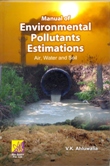
|
Manual Of Environmental Pollutants Estimations: Air, Water And Soil 2016, - V.K.Ahluwalia |
|
|
Cover Price : Rs 995.00
|
Imprint : Ane Books Pvt. Ltd.
ISBN : 9789382127444
YOP : 2016
|
Binding : Hardbound
Total Pages : 156
CD : No
|
|
About the Book
It is a well-known fact that the environment is continuously and consistently polluted by each passing day both by natural process and man-made sources. The natural processes include forest fires, natural organic or inorganic decays, volcanic eruptions, earthquakes etc. The man-made sources include rapid population explosion, deforestation and modern technology. In fact, rapid industrial and technological developments all over the world have resulted in release of poisonous matter (gases and other byproducts) into air, water and land. The manufacturing units engaged in the production of drugs, antibiotics, dyes and agrochemicals have added to the environmental pollution. Excessive use of agrochemicals has added to the problem of soil pollution. All these pollutants have hazardous effect on human health. Besides, some of the pollutants are also responsible for Global warming, Ozone layer depletion and Acid rain.
In view of the hazardous effects of various pollutants, as a first step it is important to test the presence or absence of these pollutants and subsequently their estimation. This requires the use of highly sensitive and accurate but complex instruments. The present book deals with analysis of such pollutants in air, water and land.
Air pollutants include the gaseous pollutants like carbon monoxide, carbon dioxide, sulphur dioxide, nitrogen dioxide, hydrogen sulphide and solid pollutants like particulate matter, metallic pollutants etc. Besides, noise and radioactivity are other pollutants in the air.
The water analysis include determination of water quality parameters, including total dissolved solids in water, determination of alkalinity and concentration of ammonia, nitrogen, soluble chloride, soluble sulphates and nitrates. The pH of water, its conductance, hardness, Chemical Oxygen Demand (COD), Biological Oxygen Demand (BOD) are other parameters which must be determined. Metallic pollutants in water include- trace elements, mercury, cadmium, arsenic, lead, selenium, beryllium, chromium, copper, iron. Other pollutants include fluoride, pesticides and radioactivity. Methods of estimation of all the water pollutants have been described.
Soil analysis includes determination of its pH, conductance, amount of organic matter, available nitrogen, sulphur, phosphorus, manganese, calcium, magnesium, iron, sodium, potassium, pesticides and water soluble cations and anions. Methods for the detection and estimation of all the pollutants in soil have been described.
It is hoped that this book will be extremely helpful for all studying Environment.
Contents
1. Air Analysis 2. Water Analysis 3. Soil Analysis, Appendices, Index
About the Author
V.K. Ahluwalia has worked as Professor of Chemistry, University of Delhi, Delhi for more than three decades and taught Graduate, Postgraduate and M.Phil. students. He has guided about 70 students for M.Phil./Ph.D. degrees and has published more than 250 research papers in National and International Journals. He has delivered a number of invited lectures in India and Abroad.
Prof. Ahluwalia worked as Post-doctoral Fellow for two years (1960–1962) and worked with Prof. Harold Shechter at the Department of Chemistry, Ohio State University, Ohio, USA and for one year (1980–81) with Professor Herbert C. Brown, Nobel Laureate at the Department of Chemistry, Purdue University, USA.
He has also been a Visiting Professor at Dr. B.R. Ambedkar Centre for Biomedical Research University of Delhi, Delhi.
Prof. Ahluwalia is author of a number of books on Reaction Mechanism, Green Chemistry, Environmental Chemistry and Organic Synthesis.
|
|
 |
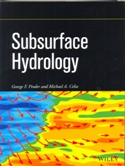
|
SUBSURFACE HYDROLOGY, INDIAN REPRINT 2014 - GEORGE F. PINDER (EX) |
Author |
GEORGE F. PINDER
MICHAEL A. CELIA
|
|
Cover Price : Rs 3,495.00
|
Imprint : Wiley India
ISBN : 9788126543694
YOP : 2014
|
Binding : Hardbound
Total Pages : 482
CD : No
|
|
This text features a comprehensive examination of water movement as well as the movement of various pollutants in the earth's subsurface. The authors also discuss the movement of fluids other than water in the subsurface such as oil, gasoline, and other liquids that may serve as sources of contamination. The multidisciplinary approach covers the topic from both a scientific and engineering perspective, integrating such fields as earth science, fluid mechanics, mathematics, statistics, and chemistry.
Rather than focus on the physical systems themselves, this text takes a practical approach by stressing methodology. Readers are provided with a full discussion of the practices, procedures, and rules for dealing with groundwater. Among the important topics covered are:
• Fluid and multi-fluid flow and transport
• Water movement in geological formations
• Analytical solutions for flow problems
• Well hydraulics
• Numerical solutions of the groundwater flow equation
• Contamination of subsurface water and remediation
• Groundwater and surface water interaction
Figures, diagrams, charts, and tables are used liberally throughout the text to help readers visualize various procedures and subsurface structures. A summary is included at the end of each chapter to highlight key concepts. Problem sets at the end of each chapter give readers an opportunity to test their knowledge and practice their new skills.
With its emphasis on methodology, this is an excellent reference to groundwater principles and practices for any scientist or engineer involved in the field. Moreover, the use of problem sets and the logical presentation of materials make this appropiate as an upper-level undergraduate and graduate textbook for courses in groundwater hydrology and hydrogeology.
Contents
Preface.
1. Water and the Subsurface Environment.
2. Fluid Flow and Mass Transport.
3. The Geologic Setting.
4. Water Movement in Geological Formations.
5. Analytical Solutions for Flow Problems.
6. Well Hydraulics.
7. Numerical Solutions of the Groundwater Flow Equation.
8. Contamination of Subsurface Water.
9. Groundwater-Surface Water Interaction.
10. Remediation.
11. Multi-fluid Flow and Transport.
Index
GEORGE F. PINDER, PhD, is Director of the Research Center for Groundwater Remediation Design and Professor of Civil and Environmental Engineering, Mathematics, and Computer Science at the University of Vermont. He has published many important articles and books, including Groundwater Modeling Using Geographical Information Systems (Wiley). Dr. Pinder's research focuses on the development and application of applied mathematics, especially numerical mathematics, to solve groundwater contamination and supply problems using computers.
MICHAEL A. CELIA, PhD, is Professor and Chair in the Department of Civil and Environmental Engineering at Princeton University. Dr. Celia conducts research in the areas of groundwater hydrology, numerical modeling, contaminant transport simulation, and multiphase flow physics.
|
|
 |
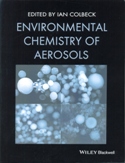
|
Environmental Chemistry of Aerosols, Indian Reprint - Ian Colbeck |
|
|
Cover Price : Rs 4,995.00
|
Imprint : Wiley
ISBN : 9788126552061
YOP : 2014
|
Binding : Hardbound
Total Pages : 268
CD : No
|
|
Contents
1. Physical and Chemical Properties of Atmospheric Aerosols.
2. Nucleation.
3. Mass Transfer to Aerosols.
4. Organic Aerosols.
5. Metals in Aerosols.
6. Thermodynamics of aqueous systems.
7. Stratospheric Chemistry: aerosols and the ozone layer.
8. Aerosol Chemistry in Remote Locations.
Index
|
|
 |
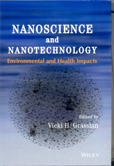
|
Nanoscience and Nanotechnology - Vicki H.Grassian |
|
|
Cover Price : Rs 4,495.00
|
Imprint : Wiley
ISBN : 9788126553587
YOP : 2015
|
Binding : Hardbound
Total Pages : 494
CD : No
|
|
As more and more nanomaterials are developed and more and more applications for nanomaterials are discovered, questions about how these materials affect the environment and human health are becoming increasingly urgent. With articles contributed by leading researchers, this book examines the results of recent scientific studies that have begun to provide answers to these very important questions. These answers, in turn, will help shape sound environmental policies that will permit the continued growth of nanoscience and nanotechnology.
This book is divided into three sections:
Section I, Environmental and Health Impacts of Nanomaterials: Overview and Challenges, sets forth key foundational information, including an overview of commercially produced nanomaterials and their potential to get into the environment
Section II, Fate and Transport of Nanomaterials in the Environment, examines what happens when nanomaterials get into the environment, emphasizing their impact on water and soil
Section III, Toxicity and Health Hazards of Nanomaterials, explores how nanomaterials affect the environment and its biota, presenting the results of investigations on living systems, including biological components, cells, simple organisms, animals, and humans
Reflecting the need for interdisciplinary research in this area, the book′s contributing authors represent a broad range of disciplines, including chemistry, microbiology, engineering, medicine, and occupational and environmental health. With the number of nanotechnology–based products expected to grow substantially in the near future and beyond, researchers and regulators should turn to this book for help in addressing the many questions concerning the impact of nanoscience and nanotechnology on health and the environment.
Contents
Preface.
Contributors.
PART I ENVIRONMENTAL AND HEALTH IMPACTS OF NANOMATERIALS: OVERVIEW AND CHALLENGES.
Chapter 1: Nanomaterials and the Environment (Mai A. Ngo, Suzette Smiley-Jewell, Peter Aldous, and Kent E. Pinkerton).
Chapter 2: Assessing the Life Cycle Environmental Implications of Nanomanufacturing: Opportunities and Challenges (Vikas Khanna, Yi Zhang, Geoffrey Grubb, and Bhavik R. Bakshi).
Chapter 3: An Integrated Approach Toward Understanding the Environmental Fate, Transport, Toxicity, and Health Hazards of Nanomaterials (John M. Pettibone, Sherrie Elzey, and Vicki H. Grassian).
PART II FATE AND TRANSPORT OF NANOMATERIALS IN THE ENVIRONMENT.
Chapter 4: Properties of Commercial Nanoparticles that Affect Their Removal During Water Treatment (Paul Westerhoff, Yang Zhang, John Crittenden, and Yongsheng Chen).
Chapter 5: Transport and Retention of Nanomaterials in Porous Media (Kurt D. Pennell, Jed Costanza, and Yonggang Wang).
Chapter 6: Transport of Nanomaterials in Unsaturated Porous Media (Lixia Chen and Tohren C.G. Kibbey).
Chapter 7: Surface Oxides on Carbon Nanotubes (CNTs): Effects on CNT Stability and Sorption Properties in Aquatic Environments (Howard Fairbrother, Billy Smith, Josh Wnuk, Kevin Wepasnick,William P. Ball, Hyunhee Cho, and Fazlullah K. Bangash).
Chapter 8: Chemical and Photochemical Reactivity of Fullerenes in the Aqueous Phase (John D. Fortner, Jaesang Lee, Jae-Hong Kim, and Joseph B. Hughes).
Chapter 9: Bacterial Interactions with CdSe Quantum Dots and Environmental Implications (Jay L. Nadeau, John H. Priester, Galen D. Stucky, and Patricia A. Holden).
PART III TOXICITY AND HEALTH HAZARDS OF NANOMATERIALS.
Chapter 10: Potential Toxicity of Fullerenes and Molecular Modeling of Their Transport across Lipid Membranes (Dmitry I. Kopelevich, Jean-Claude Bonzongo, Ryan A. Tasseff, Jie Gao, Young-Min Ban, and Gabriel Bitton).
Chapter 11: In Vitro Models for Nanoparticle Toxicology (John M. Veranth).
Chapter 12: Biological Activity of Mineral Fibers and Carbon Particulates: Implications for Nanoparticle Toxicity and the Role of Surface Chemistry (Prabir K. Dutta, John F. Long, Marshall V. Williams, and W. James Waldman).
Chapter 13: Growth and Some Enzymatic Responses of E. Coli to Photocatalytic TiO2 319 (Ayca Erdem, Dan Cha, and Chin Pao Huang).
Chapter 14: Bioavailability, Trophic Transfer, and Toxicity of Manufactured Metal and Metal Oxide Nanoparticles in Terrestrial Environments (Jason Unrine, Paul Bertsch, and Simona Hunyadi).
Chapter 15: Health Effects of Inhaled Engineered Nanoscale Materials (Amy K. Madl and Kent E. Pinkerton).
Chapter 16: Neurotoxicity of Manufactured Nanoparticles (Jaime M. Hatcher, Dean P. Jones, Gary W. Miller, and Kurt D. Pennell).
Chapter 17: Occupational Health Hazards of Nanoparticles (Patrick T. O’Shaughnessy).
References.
Index.
Vicki H. Grassian, PhD, is Professor of Chemistry at the University of Iowa. She currently directs the Nanoscience and Nanotechnology Institute. The National Science Foundation, Environmental Protection Agency, Army Research Office, and the National Institute for Occupational Safety and Health fund her research on nanoscience and nanotechnology in environmental processes and human health. In addition to journal articles, Dr. Grassian has contributed to the Encyclopedia of Nanoscience and Nanotechnology and edited the book Environmental Catalysis. Dr. Grassian chaired the symposium "Nanoscience and Nanotechnology: Environmental and Health Impacts" at the 25th annual meeting of the Society of Environmental Toxicology and Chemistry.
|
|
 |
|